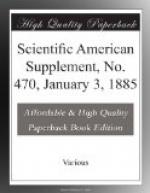But the case with regard to textiles made from vegetables fibers is quite different; upon materials made from cotton, flax, jute, or other fiber of the vegetable kingdom, the new aniline colors cannot be fixed without the assistance of other bodies acting the part of mordants. Some of these bodies are actively poisonous in their nature, and introduce a possible element of danger to the wearer of the dyed article. For many years, almost the only method of dyeing cotton goods with the aniline colors consisted in a preliminary steeping in sumac or tannic acid, followed by a passage in some suitable compound of tin, and subsequent dyeing in the coloring matter. Sumac and tin have been used for two hundred years or more as the dyer’s basis for a considerable number of shades of color from old dye-stuffs; there never has been the least suspicion that there was anything hurtful in colors so dyed. Sumac or tannic acid, in combination with alumina, may be held to be equally inoffensive; now it is a fact that the great bulk of cotton goods are dyed with the aniline colors by the agency of these harmless chemicals. But of late years the dyers of certain goods, and the calico printers generally, have found an advantage in the use of tartar emetic, and other compounds of antimony, to fix aniline colors; besides this, some colors are fixed in calico printing by means of an arsenical alumina mordant; it need not be mentioned that antimony, as well as arsenic, is, when administered internally, an active poison in even small quantities, and that externally both are injurious under certain conditions. An alarmist would require nothing further than this statement to feel himself justified in attributing everything




